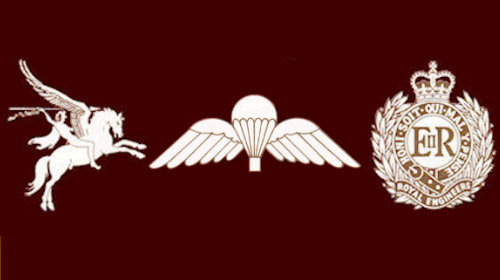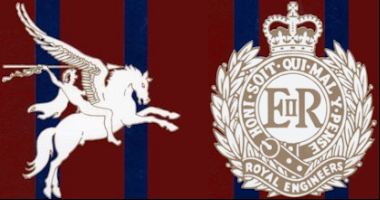
Roll of Honour
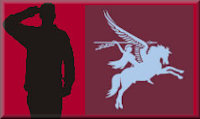
Major Douglas Campbell Murray MC
The following was received by email from Ruth Minshall, the niece of Major Murray
Major D. C. Murray, MC, OC 1st Parachute Squadron, Royal Engineers:
From Dunkirk to Arnhem Bridge
Operation Dynamo: May 27-June 4, 1940
“A Pretty Grim Time”
In May 1940, after four months with the British Expeditionary Force, 2/Lt Douglas Campbell Murray, 253 Field Company, Royal Engineers (attached to the British 9th Infantry Brigade) is ordered to withdraw from Belgium and France. He blows up bridges to slow the enemy advance, fights on the front line as infantry, and, with the Company, retreats towards Dunkirk. Most of 253 Field Company, RE manage to scramble aboard two over-loaded destroyers. Four officers and a handful of Sappers remain on the Bray beach, north of Dunkirk, the only Allied port in France.
Now promoted to Captain, D. C. Murray is one of the few Royal Engineers who escapes from the Dunkirk beaches in an open row boat. Enemy ships are in the English Channel, deadly aircraft fill the skies, mines are thick upon the waves. Led by Major Mark Henniker, Douglas and his companions find a larger drifting boat, with drinking water and some rations; a rudder is improvised and the engine repaired. After five nights without sleep, and two-and-a-half days at sea, Douglas, three other officers, and 28 exhausted soldiers*, are welcomed aboard a Royal Navy ship bound for Dover. His only possessions are his wet uniform, gas mask and miniature compass.
In England Captain D. C. Murray reunites with his unit. He writes to his wife recalling “a pretty grim time” during the retreat, escape from the beach, and perilous crossing of the EnglishChannel. Within the month, his kit and equipment are replaced.
 |
A new father, he is ready to do his bit to deter an enemy invasion. He lays mines under Worthing pier and on south-coast beaches, to disrupt enemy landing craft expected to invade England before September. “A Red Beret and Two Shillings a Day” When the invasion does not take place, he volunteers for the newly formed 1st Parachute Squadron, Royal Engineers (expanded from the 1st Air Troop). In spring 1941, after seven training drops near Ringway Airport to secure his ‘wings’, plus intensive training at Hardwick Hall, Derbyshire, he is appointed 2/IC of The Squadron. Like the Sappers, the officers receive a Red Beret and two shillings a day extra pay for jumping out of a plane (the price of a packet of cigarettes). |
* Twenty of them ‘strays’ wandering on the beach.
OPERATION BITING: 27-28 February, 1942
The first Squadron assignment is a night raid to Bruneval, France. The objective is to find out about the new radar technology that identifies ships and aircraft at night and how to counter it. Major John Frost, 2nd Paratroop Battalion, leads the Raid while Captain Dennis Vernon of B Troop, an experienced electrician, leads the seven Royal Engineers. Although there are challenges, they successfully complete their task. Planned by Admiral Louis Mountbatten, the first coordinated operation by the Army, Navy and Air Force is considered a success. The equipment they retrieve and photograph provides scientists with the information they want.
NORTH AFRICA (ALGERIA AND TUNISIA)
OPERATION TORCH: November 1942 - May 1943
In October 1942 Captain D. C. Murray sails from the Firth of Clyde to North Africa. There, he serves in Algeria and Tunisia. Attached to the 1st Army, the 1st Parachute Squadron (150 strong) supports the 1st, 2nd and 3rd Parachute Regiments, often fighting as scarce infantry to secure the airfields, mountain peaks, and the coast road to Tunis.
After a brief stop in Algiers the 3rd Parachute Battalion, on 12 November 1942, drop and seize the vital airfield at Bone, on the coast between Algiers and Tunis. Four days later the 1st Parachute Battalion drop and occupy the key road junction at Beja, 90 miles south of Tunis. Both operations achieve the desired link-up with the advancing 1st Army.
On 24 November a tragic accident involves 1st Parachute Squadron, Troop A. Led by Lt.-Col James Hill, the 1st Parachute Battalion attacks a force of Italian and German soldiers at a tank storage area at the base of Gue Hill, Saudia. Troop A’s role is to mine the road to prevent enemy withdrawal or reinforcement. The engineers lay a necklace of Hawkins mines in front and behind enemy tanks. The sappers hide in culverts under the road and pop up to lay the necklace. For the first time, to improve speed, the mines are pre-primed, placed in sandbags and loaded up in backpacks. Crossing a ravine in the dark, one sapper slips and falls, detonating his mines. The other mines are set off by the blast. Instantly, 19 engineers are killed. Thereafter, Hawkins mines are never pre-primed. The close-kit Squadron are shocked by this loss, the most fatalities in a single Squadron engagement in North Africa.
Depienne Drop: March to Oudna and Madjez-el-Bab
On 29 November the 2nd Battalion target three airfields 30 miles from Tunis. Commanded by Lt-Col Frost from the Bruneval Raid (with Royal Engineers C Troop) they jump into the airfield at Depienne, to attack the landing ground and destroy enemy aeroplanes. Due to faulty intelligence the airfield is deserted.They march through a bitterly cold night 10 miles to another enemy held airfield at Oudna, where they fight a desperate battle, heavily outnumbered. Trapped 50 miles behind enemy lines they are told by radio they are on their own.They are attacked by enemy infantry, armoured artillery and aircraft, with heavy casualties. A two day fight ensues.
Over half the paratroopers are killed or wounded. The men are ordered to disperse into company groups and head for Allied lines across rough mountainous terrain. Between 3-10 December, the remaining 180 men (out of 500) reach safety at Medjez-el-Bab, glad to be alive.
Unfortunately, on 18 December, Major Stephen Dorman, Officer Commanding of 1st Parachute Squadron, RE, is ambushed on a reconnaissance of an enemy tank position in the mountains. Major Dorman is missing in action. It is not until after the war that his batman, who is taken prisoner, confirms that Major Dorman was killed in an ambush.When this attack takes place Douglas Murray is in hospital for two days with a chill and a temperature of 102.
A few days after Major Dorman’s disappearance Capt. Trevor Livesey earns his Military Cross by carrying out a “brilliant three-day patrol behind enemy lines to find out whether bridges on the road to Tebourba can carry tanks.” During this patrol Capt. Livesey and two companions pass through enemy lines at night; gather valuable information about enemy plans; and avoid very close encounters with the enemy. The offensive planned for Christmas Eve is cancelled due to this intelligence. Winter rains, causing ankle-high thick mud, mean that men, lorries and tanks are unable to move.
On 24 December Douglas Murray writes to his wife: “we have purchased a live pig and beer for the men. We shall do pretty well tomorrow.” Christmas Dinner, traditionally served by the officers, is also marked by delivery of the first mail since they arrived in North Africa. This is a welcome Christmas gift for all.
 |
Wearing red berets, their faces smeared with the ochre soil of Tunisia, the enemy call the British Airborne troops “The Red Devils” to salute their fierce fighting spirit. Major Murray is seated, 2nd on the right in this image. |
Major D. C. Murray takes over as 1st Parachute Squadron, RE, Officer Commanding.
The Squadron engages in 11 tough battles. From February to late March they include: Djebel Mansour, Bou Arada, Happy Valley, Sedjenane and Tamera 1 & 2. (See Battle Honours later in this article, the book A Red Beret and Two Shillings a Day, and paradata.org.uk for these specific battles).
Fierce, sustained fighting, in adverse weather, against a well-armed enemy with air support, brings a high cost; yet the enemy have higher numbers killed, injured and captured. After three months, the Squadron helps secure the mountain peaks, passes and roads; with vigorous attacks and counter-attacks, they push the enemy through the valleys towards Tunis. The1st and 8th Armies link at Tunis as planned; the Allies control North Africa.
Major D. C. Murray’s Military Cross (MC) citation ( May 17, 1943) states:
“For gallantry and continuous devotion to duty. This officer has commanded his Squadron since December 1942 in all operations undertaken by the Parachute Brigade. His devotion to duty and gallantry displayed on all occasions have been beyond praise. His leadership has been an inspiration to all ranks, and it has been largely due to his example that his Squadron has so successfully fulfilled its many tasks.
During the recent battles in the TAMERA Sector he was personally outstanding in the clearance of many mines and booby traps, thereby enabling the Battalions to effect their successful advance, frequently leading his men in advance during reconnaissances over ground thickly strewn with the contrivances. He was also responsible for the laying of our mines and booby traps during the withdrawal on 17/18 March, many of which, it was evident during our advance, had the desired effect.”
Almost ten years older than his unmarried officers and men, married with a two year old son, they call him “Daddy” out of earshot. Like a father, his discipline is firm but fair. A high spirited group, they enjoy playing pranks. Always ready with a quip or humorous story, they face death daily as they lay landmines and defuse booby traps. “Daddy” is an accessible, easy-to-talk-to leader; they respect and admire him because he leads by example, as his MC citation notes.This highly skilled, closely-knit Squadron are proud of their achievements but, like their OC, modest in reporting them. He receives the MC on behalf of The Squadron.
 |
New volunteers replace the 30 killed in Algeria and Tunisia. (Left): Grey haired Major Murray on his only 48 hr leave - in Oran, Algeria, June 1943. |
The enemy surrenders 13 May 1943. Senior staff visit on May 26 to thank the troops for their success, including General Alexander and General Eisenhower. King George V1 flies to North Africa to present medals to senior staff. Major D.C. Murray is part of the inspection parade by The King, however, he receives his MC from The King at Buckingham Palace in March 1944.
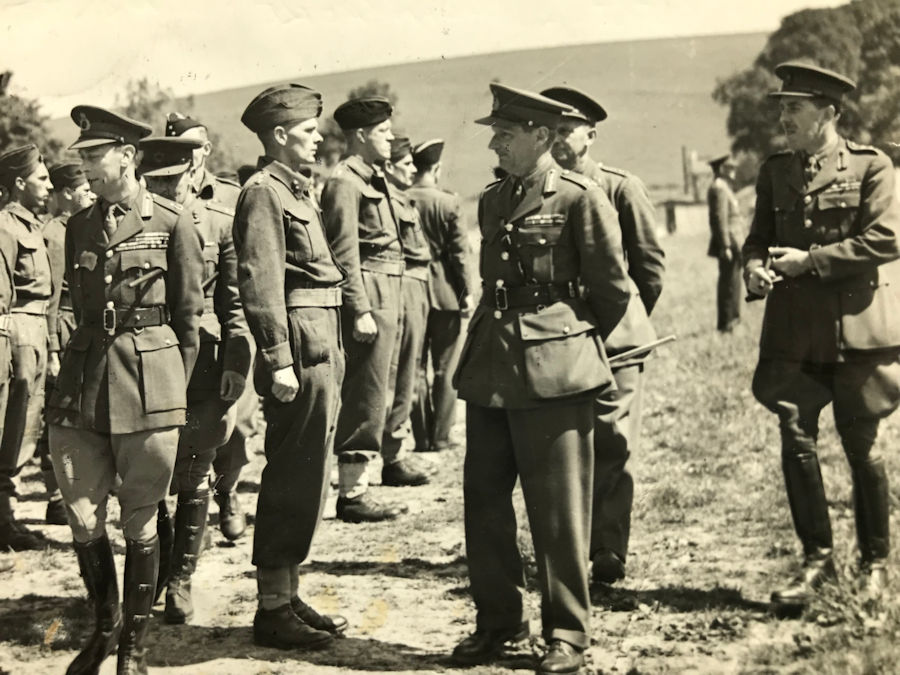 |
L to R: King George VI, General Montgomery, behind him General Alexander, far right Field Marshall Allenbrooke (Chief of the Imperial General Staff, Britain’s highest-ranking army officer, the closest military adviser to Prime Minister Winston Churchill). In the center of the image, third along, is Major D. C. Murray in profile (the shortest officer in the group at 5ft 8 inches). |
OPERATION FUSTIAN: 12-14 July 1943
In July 1943 The Squadron drop over Sicily to secure the Primosole Bridge. (He expresses regret, in a letter to his wife, that the pilot dropped him 30 miles from the action and he “missed the fun”). But The Squadron secures this key bridge until reinforcements arrive. They return to Bizerta, Tunisia, by sea, spending an afternoon at the historic city of Carthage.
There is no leave before the next Operation. They camp in tents in the shade of an olive grove (100F in the shade) near the coastal town of Sousse, south of Tunis, and bathe in the sea daily to maintain morale. During the day they climb mountain peaks, practise parachute drops and maintain fitness. To spur them on, Major Murray issues a challenge: he will race with them on the beach. Despite his great age of 30, and the searing heat, he is satisfied to come in 6th.
OPERATION SLAPSTICK: 6 September - November 1943
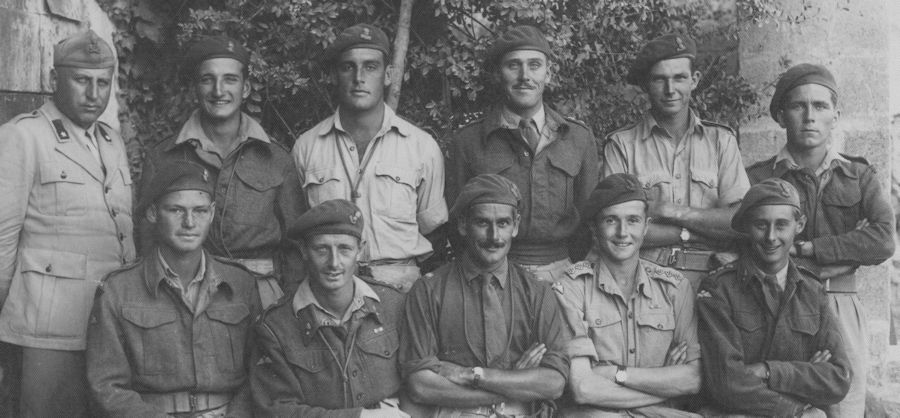 |
Officers 1st Parachute Squadron, RE, Altamura, S. Italy, Sept. 1943. L to R:Lt. Rossi (Italian), Lts. C.G. Cox, A.H. Scot Fleming, P.T. Stainforth A.E. Houghton, P. Sankey, Front: Cpts.T.C. Brockington, S. George, 2/IC, Major. D.C. Murray, RE, CO, Capts, T.J. Livesey, E.M. Mackay. |
In September, The Squadron sails to help secure Taranto port, Italy. From their mountain base at Altamura, (near Bari), they carry out successful long-range patrols in the mountains, behind enemy lines. In his letters to his wife, Hilda, in his hometown of Fleetwood, Lancashire, he notes “I haven’t slept in a bed in over a year.” Instead, he sleeps with The Squadron under canvas, beneath the stars, in barns or billets. Their rations are supplemented by whatever seasonal food can be purchased from the local people. They buy a turkey to fatten for Christmas. But late in November, as the cold winter rains begin, The Squadron returns by ship to England.
1st Parachute Squadron, Royal Engineers, September 1943, Italy.
These are the same Royal Engineers who dropped near Arnhem, The Netherlands, 17 September 1944
 |
Major D. C. Murray 2nd row seated centre with moustache. L/Cpl Gordon Spicer behind him. On Major Murray’s right: Cpt. Trevor Livesey, beside him (with moustache) Lt. Peter Stainforth On Major Murray’s left: Cpt. Eric Mackay, beside him Cpt.T. C. Brockington, Lt. Scott Fleming, Cpt. Steve George and Lt. C. G. Cox. |
Front row 3rd on left is Squadron mascot “Altamura” (an Alsatian) is, regrettably, left behind in Algiers before the Squadron returned to Britain. |
Donington, Lincolnshire: Home Base - December 1943 - September 17, 1944
The Squadron is stationed near Spalding, at the village of Donington, Lincolnshire, where they remain for nine months. New volunteers must train to The Squadron high standard of fitness. As well as marksmanship, they march (and sing) for 20 miles a day, carrying heavy packs. Their boots and voices ring out from the lanes across the countryside. In the evenings each Troop quenches its thirst at one of the seven pubs in the village. The local people give them a warm welcome, organizing dances and entertainment. Some soldiers become engaged to local women.
Sixteen missions are cancelled until Operation Market Garden. In two parts, Operation Market is the Airborne segment, while Garden is the ground force. They drop at Arnhem, The Netherlands, on September 17, 1944. This is the biggest air and land battle in the history of warfare to this date. It involves 30,000 troops including 10,000 airborne. Finally, the airborne troops can show their skills. They are instructed to secure a bridgehead for the Allied Army to enter Germany, giving a direct route to Berlin, thereby shortening the war by six months.
Sept 17- 21, 1944 The Battle for Arnhem Bridge
Despite challenges, the lightly armed British paratroopers reach their objective at Arnhem Bridge on time. Major D.C. Murray, 1st Parachute Regiment, Royal Engineers (Officer Commanding) is assigned to Parachute Brigade Headquarters to provide leadership and coordinate the engineering plans for Troop A, B and C at the Bridge. Due to wounds, the two most senior Headquarters’ staff do not arrive for two days then are side-lined by injury. As every single person is needed on the front line, Headquarters’ staff are allocated to units in various buildings.
Major D.C. Murray takes up position with Captain Trevor Livesey, MC, Commander of Troop B, at the bridge. Elements of Troop A, B and C are at the School Building, on the opposite side of the bridge, with Captain Eric Mackay. They are without wireless communication and cannot be reached because of the intense enemy fire.
As in with withdrawal to Dunkirk, and in North Africa, Major D.C. Murray’s sound judgement and steadfast courage under fire set an example for his officers (who had served with him since 1942) and his Sappers. A battle of prolonged and intense fierceness and fury is fought. The 700 soldiers at Arnhem Bridge, lightly armed, are surrounded by a much greater enemy force with tanks.They are cut off with no communication system. Systematically, the buildings occupied by the paratroopers are blown up at point-blank range by enemy Tiger tanks. The buildings burn and collapse onto the Airborne soldiers.Without food, water or ammunition, surrounded by the enemy, the situation is bleak. The promised relief has not arrived. They are on their own.
Major D.C. Murray:
- Assesses the feasibility of reaching the explosives placed under the bridge and whether they can be disabled to keep the bridge intact for the Allied soldiers to cross en route to Germany.
- Tries to find boats to take the soldiers across the river to secure the south end of the bridge.
- With no working radios or communication systems, he passes information between Major Frost in 2nd Parachute Battalion and the other officers at the Bridge.
- Carries out reconnaissance to determine:
- the best placement of the dwindling number of uninjured soldiers in the few remaining buildings
- the safety of the over 300 wounded;
- the location of enemy forces (often under cover of darkness);
- possible escape routes.
They hold out at Arnhem Bridge - not for two days (the maximum expected) - but for four days and nights. Major D. C. Murray is forced to surrender on the fifth morning, September 22, 1944. The lesson from Arnhem is that there will be no speedy end to the war.
Taken Prisoner of War (POW)
Together with Captain Trevor Livesey and Captain Steven George 2/IC, Major D.C. Murray is held in the main church in Arnhem for 36 hours. He is then transported by lorry and rail. His only food in five days is a cup of soup from a woman at a canteen in Frankfurt Rail Station.
Oct 6 - April 1945 Major D.C. Murray is held at Brunswick Officer’s Camp #79, Lower Saxony, Germany. He receives no correspondence from Britain while a POW. His distraught wife wonders if he is dead or alive. After the Allied bombing of Dresden his half-ration Red Cross food parcel is further reduced.
April 15 1945: Liberated by USA troops, he is flown by the Red Cross from Frankfurt to Brussels and on to England. Victory in Europe (VE Day), on May 8th, marks the end of the War in Europe. By then Major Murray is on leave with his sister and her family in Scotland; there he regains his 30 lbs of lost weight and recuperates, before his wife and son join him.
Return to Civilian Life
After demobilization, in August 1945, Douglas Murray resumes his municipal engineering job in Darlington. His family join him. This is first time they have lived together as a family since the war began. The following year he takes up the post of Municipal Engineer at Ipswich, Suffolk.
He becomes Deputy, then Chief Engineer and Planning Officer, for Reading, Berkshire from 1952 - 1973. He retires at 60 as Chief Borough Engineer and Planning Officer, responsible for a much expanded local government region that includes Reading.
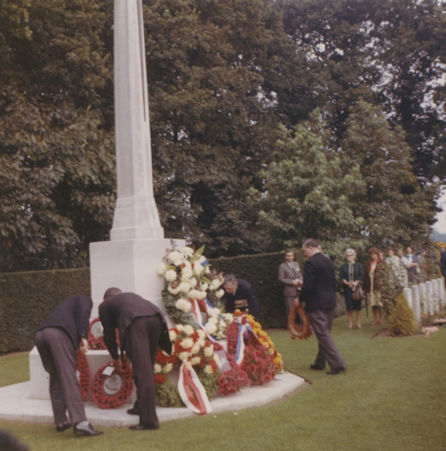 |
Arnhem 50th Reunion and The Arnhem Veterans’ Association. Douglas attends events in 1994 in Arnhem - to commemorate the 50th anniversary of The Battle of Arnhem Bridge - together with his batman, L/Cpl. Gordon Spicer. When their Dutch hosts express appreciation for The Squadron’s wartime efforts at Arnhem Bridge their tongues are ‘loosened’; this visit enables them, at last, to talk about their wartime experiences. |
 |
|
L to R: Brig. Flavell holds the wreath, Lt. Col. Frost, Major D. C. Murray (beret lost by a friend at a costume party), Lt. Gen. Sir Fredrick Browning (in brown jacket). Major Murray becomes the last surviving senior airborne officer from Arnhem Bridge. |
|
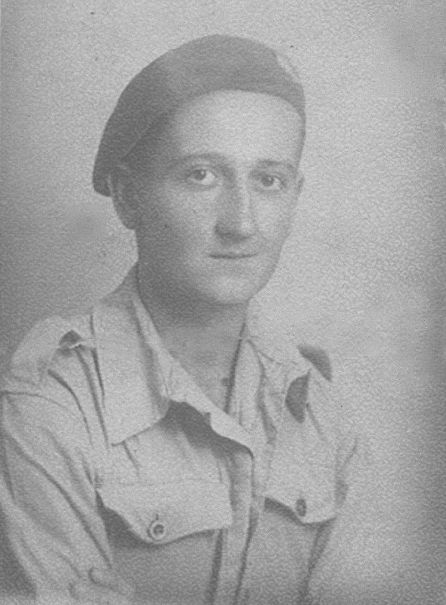 |
Gordon Spicer, aged 22 (left). Major Murray’s batman since North Africa, Gordon is wounded by a sniper when he defends Arnhem Bridge. His leg, amputated in a German hospital while a POW, gives him excruciating “phantom limb” pain for the rest of his life. They keep in touch with remaining comrades through: the Airborne Engineers’ Association; the Arnhem Veterans’ Association; and the annual Parade and Memorial Service held at St Mary and the Holy Rood Church, Donington, the last Sunday morning in September. (Led by retired Col. Chris M. Davies, MBE). |
These memorial events at Donington continue to bring together past and present paratroopers, families, friends, local residents, and admirers of 1st Parachute Squadron, R.E.
All are welcome to attend.
St Mary and the Holy Rood Church, Donington, devotes a chapel to The Squadron.
The Roll of Honour (inscribed by Mrs. Betty Gray) lists the names of the fallen.
Their battle honours are written on a wooden wall panel, as follows:
1st Parachute Squadron, Royal Engineers, Battle Honours 1942-1945
1942 FRANCE - Bruneval
1942/43 NORTH AFRICA - Depienne, Oudna Airfield, Sidi Bou Hadjeb, Elfedja,
Medjez-el-Bab, Sidi N’Sir, Djebel Mansour, Bou Arada, Happy Valley,
Sedjenane, Tamera.
1943 SICILY - Primosole Bridge.
1943 ITALY - Taranto - Long Range Patrols.
1944 HOLLAND - Oosterbeek, Arnhem.
Douglas Murray dies in 2005 of heart failure in his 92nd year. His wife dies three years later.
They are survived by their son and his partner, nephews and nieces.
At his cremation service at Oxford, Sapper Ron “Pinky” White travelled from USA to pay tribute to his Officer Commanding. Speaking on behalf of those who had served in The 1st Parachute Squadron, Royal Engineers, 1941-44, he recalls that Douglas appreciated a humorous situation; had high standards yet was approachable; was a fine example to his officers and men.
The elite 1st Parachute Squadron, RE played a key role at pivotal points during the war when a different result could have been dire for Britain and Europe.
- In France, at Bruneval, when Britain needed to find out about the new radar technology that identified ships and aircraft in the dark and how to counter it.
- In North Africa where supply bases were established to gain control of the Mediterranean Sea and launch subsequent Allied operations against Italy.
- In Sicily and Italy where key ports, bridges and towns controlled access to the ‘boot’ of Italy.
These gave the Allies supply routes into enemy controlled Europe as well as access to airfields that would allow year-round refuelling of Allied planes. From there they could reach into central Europe, including Southern Germany. - At Arnhem Bridge, The Netherlands, as in North Africa, the paratroopers gained the respect and admiration of their enemy. The name ‘Arnhem Bridge’ now signifies tenancy and courage against overwhelming odds. It is a legend in airborne history.
Yet for Major D.C. Murray it was not about war - but about regaining peace - to enable him to return to his family. During a 1999 interview with his niece (Minshall, 2020), Major Murray recalled his military service with a mixture of modesty and pride:
“…we did your duty. Did what we had to - to the best of our ability.”
Summary of military service:
- 1939 September 29 Gazetted: 2nd Lieutenant, Royal Engineers (R.E.). with effect 13 August 1939, Supplementary Reserve of Officers.
- 1939 - Jan 1940: 107A Troops Coy.: August 50 Div. R.E. : Oct. - Nov. 48 Div. R.E. : 1939 Nov - 1940 Jan.
- 1942 Jan. - 1944 Sept. Positions held: Captain and 2nd in command, 1st Parachute Squadron, Royal Engineers. and Major and O.C. of this unit from December 1942 to September 1944. (Tunisia, Sicily, Italy, England and Holland/Arnhem).
Nature of Service Duties:
Throughout service, commands either a Section or a Squadron, Royal Engineers, in support of an Infantry Brigade or Divisional Troops on active service in Home Forces or in the above campaigns.
Detailed military service:
- 1940 Embarks for France, January.
- 1940 Jan. - June 4: Part of British Expeditionary (BEF) Force in France/Belgium.
- 1940 253 Field Coy. R.E. Jan 1940 - Nov. 1941. Campaign in France and Belgium May 1940 (Section Officer).
- 1940 May Retreat to Dunkirk - with Major (later Lt. Col) Mark Henniker. The Royal Engineers supervise the detonation of mines on
canal bridges to slow the advance of German forces during the retreat to Dunkirk. - 1940 June 4 Evacuation from Dunkirk: Major Henniker, three officers (including Capt. Murray) and 28 soldiers spend two and half days
and nights in open boats, including a row boat, before they reach safety in England.
Blackwoods Magazine article “Small Change from Dunkirk” by Major Henniker, (Nov. 1940) recounts the withdrawal and sea voyage from Dunkirk. Major Murray considers this article to be an accurate record of his experiences. - 1941 October: Volunteers for the 1st Parachute Squadron, Royal Engineers.
Parachute Training Centre Ringway Airport, Manchester. Billeted in Knutsford.
Five jumps from a barrage balloon and two from an aircraft at Trafford Park required to qualify for ‘wings’.
Advanced training at Hardwick Hall Paratroop Training Centre, near Chesterfield. Lt. Colonel E.W.C. Flavell Officer in Charge.
Adjutant John Frost records training experiences in his book “A Drop Too Many.” - Nov 1941 - Jan 1942 103A Troops Coy. Marine Division (Section Officer).
- 1942 January: Training on Salisbury Plain, Tilshead Camp, under General Browning.
Preparation for secret, night raid behind enemy lines.
Jan - Feb: Marine training at Inveraray, Loch Fyne, Scotland.
Night exercises to evacuate from beaches with landing craft. - 1942 February: Bruneval Raid, near Le Havre, France. Sr. Officer Major John Frost.
Bruneval is the first combined Army, Air and Naval operation to successfully demonstrate how Paratroopers could drop behind enemy
lines at night, use the element of surprise to overcome a gun battery, remove German equipment for later scrutiny, and be taken off
the nearby beach by a Naval boat. See John Frost Obituary and his book A Drop Too Many, (1980).
North Africa British Expeditionary Force
- 1942 Nov: By sea to Gibraltar then Algiers to drive the enemy out of Tunis (and North Africa) by joining together the 1st and 8th Armies. The R.E. is attached to the 1st Army, to support 1st, 2nd and 3rd Parachute Regiments. Their job is to destroy enemy aircraft landing zones and disrupt transportation. They lay landmines, destroy bridges and, when required, are infantry marksmen.
- 1942 Dec 25: Beja area operations, then back towards Algiers by sea.
- 1943 Jan. Becomes Major Murray and Officer Commanding of the Squadron when Major Dorman is missing in action - ambushed on patrol by enemy.
- 1943 Jan: Inland from Algiers to Bou Arada area for 6 weeks. Tough battles.
- Feb 26: 3rd Battalion requires vigorous help from Parachute R.E. Squadron.
- March 7- 29: Battle of Tamara. Major Frost and 2nd Para at Cork Wood are strengthened by troops of R.E. Squadron which takes over
left flank, nicknamed The Citadel.
Sedjenane Valley: severe fighting involving R. E.
- May 9-10: Line forced back to Tabarka then a comeback. Led by Lt. Col. Tom Pearson who earns a bar for his DSO.
- May 13: Victory on the North African coast. Tunis secured.
Eleven Battle Honours in North Africa:
- Depienne; Oudna Airfield; Sidi Bou Hadjeb; Elfedja, Medjez-el-Bab; Sidi N’Sir; Djebel Mansour; Bou Arada; Happy Valley; Sedjenane, Tamera Phase 1 and 2.
- May 19: Royal Engineers on front line for many months with no leave.
- May 26 Major Murray is introduced to General Alexander at inspection.
- June 6 The Red Devils: “The Battalion is magnificent and has earned the name.” June 6: Major Murray persuades senior staff to give
The Squadron 48 hrs leave in Oran. There, they enjoy bathing in the sea. This is their first leave in North Africa. - June-July: Sousse - daily bathing in the sea a boost to morale in fierce heat. Parachute training and physical stamina training for next operation.
- June 1943 King George VI visits to present medals to senior staff. 1943 Sept 23. Major Murray is awarded the Military Cross for bravery
and distinguished service in the North African campaign (Algeria and Tunisia). King George VI presents the award at Buckingham Palace
in March 1944.
Sicily and Italy
- July 13-14 1943 Sicily - Operations Husky and Fustian The largest combined maneuver in history involves the land, sea and air forces
of two nations (USA and British) in Sicily. Gen. Montgomery’s 8th Army lands in the east while Lt. Gen. George Patton’s US 7th Army comes ashore in the west. These are supported by airborne assaults. - 1st Para Battalion, R.E. Squadron drops at Taranto to secure the port then defends Primosole Bridge with fierce, severe fighting lasting
3 days. - Aug - December 1943 Based initially at Altamura, near Bari in S. E. Italy, with 8th Army. In mountainous terrain; they sleep on the ground or in tents. After the Italian armistice, they move every few days, clear landmines, secure bridges and roads, and carry out successful
long range patrols into enemy held terrain. - Battalion and Squadron photos taken in Italy.
The Netherlands
- September 17 1944 Arnhem - Operation Market Garden
The biggest land, sea and air campaign in the history of warfare. Gen. Montgomery hopes a ‘full blooded thrust’ will shorten the war
by 6 months, overrun the industrial heartland of Germany that produces armaments, and secure Berlin (instead of the Russians). Due
to a series of planning errors the plan fails. - Sept 17- 21, 1944 The Battle of Arnhem Bridge
Despite challenges, the Allied paratroopers reached their objective at the Arnhem Bridge on time and held out - not for two days (the maximum expected) - but for four days and nights, being forced to surrender on the fifth morning. - Major Murray, 1st Parachute Squadron, Royal Engineers (Officer Commanding) is assigned to Parachute Brigade Headquarters to provide leadership and coordinate the engineering plans for Troop A, B and C at the Bridge. Due to wounds, the two most senior Headquarters’ staff did not arrive for two days then are side-lined by injury.
- Major Murray assessed the feasibility of reaching the explosives placed under the bridge and whether they could be disabled to keep
the bridge intact for the Allied soldiers to cross en route to Germany. He tries to find boats to take the soldiers across the river to
secure the south end of the bridge. With no working radios or communication systems, he passes information between Major Frost in
2nd Parachute Battalion and the other officers at the Bridge. He also carries out reconnaissance to determine: the best placement of
the dwindling number of uninjured soldiers in the few remaining buildings; the safety of the wounded; the location of enemy forces (often under cover of darkness); possible escape routes.
Taken Prisoner of War (POW)
- 1944 September 22: Surrounded, with no ammunition, Major Murray is forced to surrender. Together with Captain Livesey, MC, Commander of B Troop, and others, Major Murray is held in the main church in Arnhem for 36 hours.
- 1944 September 23 - 25 healthy officers, including Major Murray, are moved by lorry to Zutphen.
- Massacre of Prisoners of War near Zutphen: two officers escaped from the lorry and the young SS soldier opens fire on the officers in the back of the lorry, killing 6 (including an elderly German soldier) and wounding many more. A passing German Intelligence Officer prevents more deaths.
- Zutphen - Frankfurt - Brunswick Oflag X11B Officers’ Prisoner of War Camp
- Transport by road and rail with no food except one small cup of soup at Frankfurt.
- 1944 Oct 6 - April 1945 Brunswick Officer’s Camp #79, Lower Saxony, Germany. No correspondence from Britain received while a POW.
- 1945 April: Liberated by USA troops. Flown by the Red Cross from Frankfurt to Brussels and then to England.
1945: May 8: Victory in Europe (VE Day). End of the War in Europe.
- 1945 June-July: Holiday on farm in Scotland with sister, Kath Milroy, and her family to regain weight and recuperate before wife and son join him.
- 1945 August - Demobilization.
- 1945 August resumes his municipal engineering job in Darlington. His wife and young son live with him in Darlington.
- 1946: Takes up the post of Municipal Engineer at Ipswich, Suffolk. Rents a flat and begins to build a life with his family.
- 1952 Deputy, then Chief Engineer and Planning Officer, for Reading, Berkshire.
1973 Retires at 60 as Chief Borough Engineer and Planning Officer responsible for a much expanded local government region that
includes Reading.
Member of the Arnhem Veteran’s Association. After the 50th anniversary of The Battle of Arnhem, together with his Batman, Gordon Spicer, attends annual reunions at Donington, Lincolnshire, where the Squadron had been stationed during the war. Gordon Spicer was wounded at Arnhem Bridge and had his leg amputated. Douglas and Gordon Spicer become close friends. From 1994 they frequently talk about their wartime experiences and keep in touch with remaining comrades at the annual Parade and Memorial Service held at St Mary and the Holy Rood Church, Donington, the last Sunday in September. (These events continue, led by Col. Chris M. Davies, MBE).
2005 January: Douglas dies at Royal Berkshire Hospital, Reading, of heart failure, having devotedly looked after his wife, Hilda, who had declining health for ten years. She dies in 2007. Survived by their son, his partner, nieces and nephews.
Major Murray is cremated at Oxford. At this service Sapper Ron “Pinky” White pays tribute to his Commanding Officer. Speaking on behalf of those who had served in the 1st Parachute Squadron, Royal Engineers, 1940-44, he recalled that Douglas appreciated a humorous situation; had high standards yet was approachable; a fine example to his officers and men.
In 1999, during an interview with his niece (Minshall, 2020), Major Murray recalled his military service with a mixture of modesty and pride:
“…we did your duty. Did what we had to - to the best of our ability.”
For a more detailed account of Major Murray’s wartime experiences see the book:
A Red Beret and Two Shillings a Day. The First Airborne Engineers 1941-1945.
The Military History of Major D.C. Murray, MC, Officer Commanding (1943-45) 1st Parachute Squadron, Royal Engineers. Dunkirk to Arnhem.
Ruth C. Minshall (2020). Self published.
Available at: The Royal Engineers Library Chatham and The Imperial War Museum, Archive and Library, London.
Source of R.E. units: typed letter dated 14 October 1947, from D. C. Murray, 36 Anglesea Road, Ipswich, Suffolk to The Secretary, The Royal Institution of Chartered Surveyors, 12 Great George St, Westminster, London S.W.1. Property of Ruth C.
Minshall.
For further information contact: ruthminshall@icloud.com
January 2023

